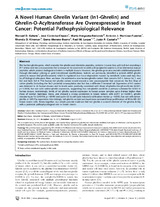Mostrar el registro sencillo del ítem
A Novel Human Ghrelin Variant (In1-Ghrelin) and Ghrelin-O-Acyltransferase Are Overexpressed in Breast Cancer: Potential Pathophysiological Relevance
| dc.contributor.author | Gahete Ortiz, Manuel D. | |
| dc.contributor.author | Córdoba-Chacón, José | |
| dc.contributor.author | Hergueta-Redondo, Marta | |
| dc.contributor.author | Martínez-Fuentes, Antonio J. | |
| dc.contributor.author | Kineman, Rhonda D. | |
| dc.contributor.author | Moreno-Bueno, Gema | |
| dc.contributor.author | Luque, Raúl M. | |
| dc.contributor.author | Castaño, Justo P. | |
| dc.date.accessioned | 2013-01-15T09:54:09Z | |
| dc.date.available | 2013-01-15T09:54:09Z | |
| dc.date.issued | 2011 | |
| dc.identifier.uri | http://hdl.handle.net/10396/8637 | |
| dc.description.abstract | The human ghrelin gene, which encodes the ghrelin and obestatin peptides, contains 5 exons (Ex), with Ex1-Ex4 encoding a 117 amino-acid (aa) preproprotein that is known to be processed to yield a 28-aa (ghrelin) and/or a 23-aa (obestatin) mature peptides, which possess biological activities in multiple tissues. However, the ghrelin gene also encodes additional peptides through alternative splicing or post-translational modifications. Indeed, we previously identified a spliced mRNA ghrelin variant in mouse (In2-ghrelin-variant), which is regulated in a tissue-dependent manner by metabolic status and may thus be of biological relevance. Here, we have characterized a new human ghrelin variant that contains Ex0-1, intron (In) 1, and Ex2 and lacks Ex3-4. This human In1-ghrelin variant would encode a new prepropeptide that conserves the first 12aa of native-ghrelin (including the Ser3-potential octanoylation site) but has a different C-terminal tail. Expression of In1-variant was detected in 22 human tissues and its levels were positively correlated with those of ghrelin-O-acyltransferase (GOAT; p = 0.0001) but not with native-ghrelin expression, suggesting that In1-ghrelin could be a primary substrate for GOAT in human tissues. Interestingly, levels of In1-ghrelin variant expression in breast cancer samples were 8-times higher than those of normal mammary tissue, and showed a strong correlation in breast tumors with GOAT (p = 0.0001), ghrelin receptor-type 1b (GHSR1b; p = 0.049) and cyclin-D3 (a cell-cycle inducer/proliferation marker; p = 0.009), but not with nativeghrelin or GHSR1a expression. Interestingly, In1-ghrelin variant overexpression increased basal proliferation of MDA-MB-231 breast cancer cells. Taken together, our results provide evidence that In1-ghrelin is a novel element of the ghrelin family with a potential pathophysiological role in breast cancer | es_ES |
| dc.format.mimetype | application/pdf | es_ES |
| dc.language.iso | eng | es_ES |
| dc.publisher | Public Library Of Science (PLOS) | es_ES |
| dc.rights | https://creativecommons.org/licenses/by-nc-nd/4.0/ | es_ES |
| dc.source | PLoS ONE 6 (8), 1-11 (2011) | es_ES |
| dc.subject | Human ghrelin | es_ES |
| dc.subject | In1-Ghrelin | es_ES |
| dc.subject | Cáncer | es_ES |
| dc.subject | Ghrelin-O-Acyltransferase | es_ES |
| dc.title | A Novel Human Ghrelin Variant (In1-Ghrelin) and Ghrelin-O-Acyltransferase Are Overexpressed in Breast Cancer: Potential Pathophysiological Relevance | es_ES |
| dc.type | info:eu-repo/semantics/article | es_ES |
| dc.rights.accessRights | info:eu-repo/semantics/openAccess | es_ES |

